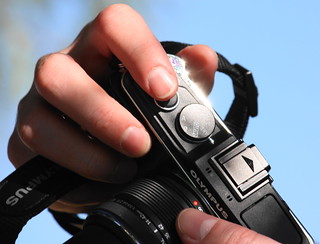 When photographer Arne Svenson was given a telephoto lens by a bird-watching friend he was keen to try it out and hit upon what seemed to him an excellent subject: His neighbours across the street. Svenson lives in lower Manhattan, and the building facing his is made up of floor-to-ceiling windows. At any time he could see three floors of urban family life and he documented a great deal of it over a year and a half. The telephoto lens captured couples having breakfast, children squabbling, people retreating to the bathroom to talk on cellphones, someone taking a nap on the couch, and other vignettes of daily life. The neighbours found out about Svenson’s project when some of the photographs were displayed in a gallery and the exhibit was written up in a local newspaper. They were shocked and angry to find themselves unaware photographic subjects and some are considering legal action.
When photographer Arne Svenson was given a telephoto lens by a bird-watching friend he was keen to try it out and hit upon what seemed to him an excellent subject: His neighbours across the street. Svenson lives in lower Manhattan, and the building facing his is made up of floor-to-ceiling windows. At any time he could see three floors of urban family life and he documented a great deal of it over a year and a half. The telephoto lens captured couples having breakfast, children squabbling, people retreating to the bathroom to talk on cellphones, someone taking a nap on the couch, and other vignettes of daily life. The neighbours found out about Svenson’s project when some of the photographs were displayed in a gallery and the exhibit was written up in a local newspaper. They were shocked and angry to find themselves unaware photographic subjects and some are considering legal action.Before Svenson embarked on the project he consulted a lawyer and was apparently told that there was little expectation of privacy in a city as crowded as New York. I find this a little surprising. Many of the previous cases involving the rights of photographic subjects involved photos taken in public places, and I would have thought that there was a basic right to privacy within one’s own home. Nonetheless, it is a little depressing that Svenson’s mulling over the ethics of his project seems not to have gone beyond consulting a lawyer. Not that I have anything against lawyers. It’s just that legality should be a minimal requirement for an action, not a signal to barge full-steam ahead.
I have read a few discussions of the case, and they are mainly of the “hand-wringing” variety. They combine a discussion of legalistic issues with consideration of the photographs’ artistic value. Are the photos “good enough” to justify the incursion of privacy, if indeed the neighbours’ expectation of privacy in their homes was reasonable? (At least a few people seem to think that it was not.) Many of the commentators find themselves torn. They admire the photos yet empathize with the neighbours’ feelings of anger and violation.
These discussions neglect some important matters. Recently in a few places I’ve seen the advice offered that it is better to ask forgiveness afterwards than to ask permission before. In other words, do what you want, act now and worry later about the consequences and those whom you may have hurt. (Not that I know whether or not Svenson has asked for forgiveness. He is said to be “surprised and upset” by his neighbours’ response. Really?)
For me, the ethical crux of the matter is that Svenson has treated his neighbours in a way in which they could not possibly have consented. One cannot consent to be secretly photographed. And Svenson did this not once or twice, but repeatedly, over about eighteen months. Then he compounded this error by displaying the photographs publicly, again without asking permission of his subjects. Even if some of his neighbours admire the photographs, they probably feel like they have treated as a means to an end – in other words used. Small wonder that they are upset.
Still, I hope that Svenson and his neighbours will find a resolution outside of a courtroom. I hear that there are some great mediators in New York City.
Hat tip: I first read about Arne Svenson and his neighbours in Raffi Khatchadourian’s “Talk of the Town” piece titled “Stakeout” in the May 27, 2013 issue of The New Yorker. I have decided not to provide a link to the photographs.
No comments:
Post a Comment